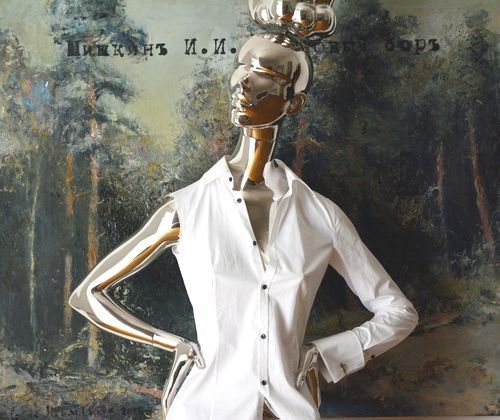Evolution vs. revolution
The Museum of Modern Art in Odesa (MMAO) is hosting the city’s third biennale
Let us recall that the Ist Odesa Biennale of Contemporary Art was held in 2008, followed by the second in two years’ time. While the first event was open to all willing artists, only Odesites were eligible for the second exhibition. The third biennale, originally scheduled for 2012, was delayed by a year due to the MMAO moving into a new building at 5 Bielinskoho Street, previously occupied by Odesa Regional Branch of the National Writers’ Union of Ukraine.
Myroslav Kulchytsky, a curator of the project, told the press that the third biennale would be fundamentally different from the previous ones as it had taken a step toward increasing international representation. There were just two selection criteria: firstly, high artistic level of the aspiring participants’ works, and secondly, their relevance for the stated problem of the project – “self-government: cultural evolution versus revolution” – which had much more to do with social and political issues than the arts. It is really interesting to see how the artists answered this question using the tools of their trade.
The project involves five displays at as much venues, that is, galleries NT-Art, KhudPromo, and Zhovti Veletni, Experimental Culture Center Chaina Fabryka, and two exhibition halls of the MMAO itself, hosting the bulk of the project. Provisionally, all artworks on display can be divided into three groups, with the first offering various ways to address the biennale’s conceptual problem, the second acting as a critique of the neo-liberal society, and the last one opposing socially engaged art.
Unusually for such projects, its co-curators Myroslav Kulchytsky and Mykhailo Rashkovetsky have allowed parallel projects of other curators into it, including ones by Oleksa Mann and Maksym Kovalchuk, called Bacterium and Weakness, respectively.
Most exhibits in the halls are installations, mannequin sculptures, and visual projects. Their minimalist spaces contain photos, audio tapes, and films recording household items. In some cases, they demonstrate the absurdity of the consumer society, the alienation of humans from the fruits of their labor (Enthusiasm. by Nakonechna and Kadan, Used Goods from Germany by Larysa Rezun-Zviezdochotova). Therefore, these works seem unlikely to interest a passive spectator who looks for sensually contemplative, figurative art.
Ambiguously, a number of projects revive seemingly antiquated styles (fauvism, futurism, primitivism), which claim the avant-garde position in the current context. Such are Mann’s and Semesiuk’s scandalous works. Thus, some creators revolt not only against the classic, time-tested art (because the styles they use are time-tested, too), but against limits on human freedom as well, set by the violent power of the state. Under these conditions, it is primarily protest against contemporary social and political circumstances narrowing the space for individual self-expression that is the artist’s contribution. From this perspective, Belarusian artist Marina Naprushkina’s project Our House: Self-Government looks highly interesting as it offers journalistic graphics accompanied by folk music, with law and order forces pictured as the enemy, suggesting parallels with modern Belarus and Ukraine’s political situations.
The creator of Barter installation and curator of the 2010 biennale Stas Zhalobniuk has presented an eccentric work. It does not lack subtext, showing two paintings in the Old Masters’ style blocked up by a few mannequins, dressed in a modern way. The artist has admitted he never buys his own clothes but exchanges pictures for them, seeing no need to participate in the monetary economy. Every appearance of this really artistic personality is a performance in itself: he came to the opening ceremony wearing... bath slippers. Zhalobniuk’s self-irony is undeniable. Hopefully, participation in this project will allow him to get a decent pair of footwear sometime.
The scope of this project is not that impressive yet. However, there has been rapid growth, with this year’s event bringing together over 80 participants from Russia, Germany, the Netherlands, Bulgaria, Romania, France, United Kingdom, United States, Estonia, and several Ukrainian cities – Odesa, Kyiv, Lviv, Kharkiv, Dnipropetrovsk, Uman, and Simferopol. Of course, Odesa and Kyiv dominate the exhibition. As for foreign nations’ representations, they consist, with rare exceptions, of immigrants from the former Soviet Union that maintain ties with the old country. Using the Soviet criteria that described “young artist” as a person under 35 years, this project is really youthful, allowing lesser-known creators an outlay for their energy. Still, some participants are known well enough, such as Yuri Albert (Russia), Dan Perjovschi (Romania), and Ukrainians Oleh Tistol, Oleksandr Roitburd, Ihor Husiev, Olha Lannyk, Lada Nakonechna, and Vasyl Tsaholov.
It seems that the organizers sought to make the event highly attended and diverse – that is, a kind of breeding ground for “bacterias” that would carry new ideas on, and they have succeeded in this effort.
The project was made possible by a grant obtained by the MMAO from the Foundation for Development of Ukraine, amounting to 100,000 hryvnias. It paid for technical and informational support of the biennale and its guests’ accommodation. Even so, Semen Kantor declared that the grant had covered only half the cost. By the way, the organizers themselves have received no pay at all, as the government agencies have contributed nothing to this endeavor from the beginning to this very moment, except for the city council’s consent to help in distributing posters. However, the presence at the opening ceremony of Tetiana Markova, head of the Department of Culture and Tourism of Odesa City Council, has brought hope that this project will not remain without attention of local authorities in the future.
The hosts have stated that the exhibition may become a triennial event in the coming years, thereby allowing the organizers to prepare for it more thoroughly, without undue haste.






